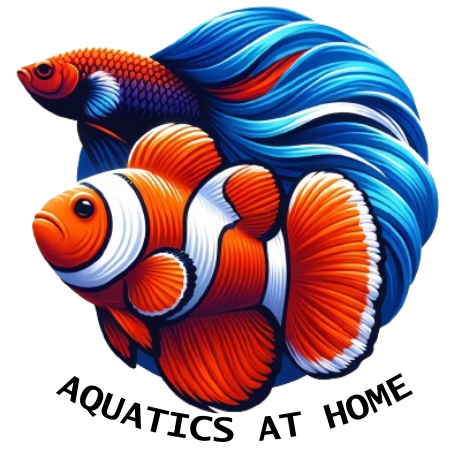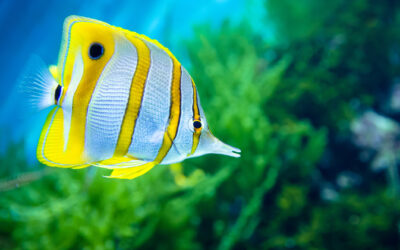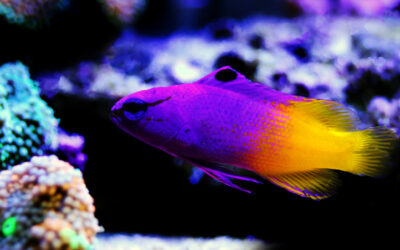Congratulations on starting your journey into the world of saltwater tanks! Adding coral to your tank can be a beautiful and rewarding experience, but without proper research, it can also be pretty frustrating. That’s why, for beginners, starting with durable and easy-to-care-for corals is essential.
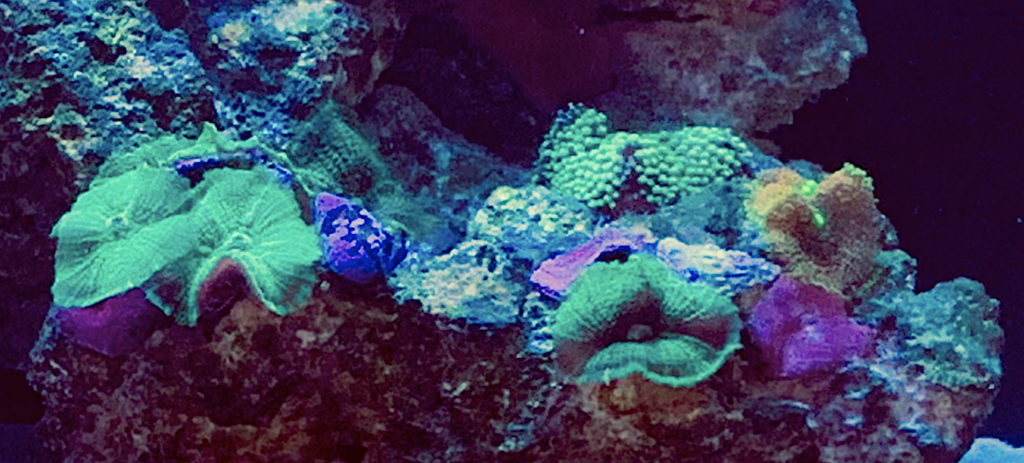
This doesn’t mean you are going to start with a bland tank – you can get some amazing and wildly colorful beginner corals! To a non-indoctrinated marine enthusiast, you will still wow people with beautiful coral at any skill level. Since I wish to emphasize the long-term betterment of corals, I like to encourage new hobbyists to start simple so that one day they can sell their beginner corals back to their LFS as they get more challenging ones. This, as they say, is the way.
I started my first saltwater aquarium with anemones, zoas, and a couple SPS with no plan, and it did not go well, to say the least. Later on, I took another run at corals with mushrooms, kenya trees, frog spawn, and pulsing xenia – all vibrant but easy to care for corals. The result was much better. Over time my corals thrived despite my slow acclimation to understanding the hobby. In all fairness, I didn’t have a blog like this to refer to – I trusted my local fish store for advice, but once my corals were on the decline, a lovely employee told me to go somewhere else as the owner was more of a salesman than an expert.
This article will cover the basics of saltwater tanks, different types of corals, and the top durable and easy starter corals. We will also discuss proper coral placement, feeding and caring for your corals, common challenges, and expanding your coral collection.
Understanding the Basics of Salt Water Tanks
Before we dive into the world of corals, let’s go over the basics of saltwater tanks. You should keep proper water parameters for the health of your tank inhabitants. Water parameters include salinity, pH, temperature, ammonia, nitrite, and nitrate levels. Testing your water regularly and performing routine water changes are essential to keep them in check.
When it comes to salinity, different types of fish and corals have different requirements. Some may thrive in lower salinity levels, while others require higher levels. Beginner inhabitants are often more resilient, but more advanced corals and fish will not be as tolerant of variation. Always research the specific needs of your tank inhabitants to ensure they are living in the best environment possible.
Importance of Water Parameters
Corals can be super sensitive to even the slightest in-water parameters, so be sure to keep them as stable as possible. In addition to salinity, pH, and temperature, you should also monitor calcium, alkalinity, and magnesium levels. These elements are crucial for the growth and health of your corals.
Calcium is necessary for the growth of coral skeletons, while alkalinity helps to maintain a stable pH level. Magnesium is important for the overall health of your corals and can also help prevent the formation of algae.
Cycling Your Salt Water Tank
Before adding any inhabitants to your tank, you need to cycle it to establish the necessary bacteria that will break down waste. This process can take several weeks to months, so patience is key. You can cycle your tank using live rock, some raw shrimp, and a chemical stabilizer like Seachem Stability.
Live rock is a popular choice for cycling a saltwater tank because it not only helps to establish the necessary bacteria but also provides a natural-looking and aesthetically attractive habitat for your tank. Raw shrimp can also be used to cycle a tank, but it is important to note that it can create a strong odor, introduce lots of ammonia, and may not be as effective as live rock. Chemical dosing can help a great deal, and in time, you will need to add some fish. As hard as it is to say, these first brave swimmers are going to bare the most risk as you start your environment.
Choosing the Right Equipment
Investing in quality equipment is important, though not quite essential, for the success of your tank. A good protein skimmer, heater, and lighting system are necessary for maintaining water quality and providing the appropriate light spectrum for your corals, but the frequency of water changes, your ability to dose in a stable manner, and your tank size can impact what you truly need. I had corals in a smaller aquarium without a protein skimmer for years, but I monitored my levels closely.
When it comes to protein skimmers, there are a variety of options available on the market. It is important to choose one that is appropriately sized for your tank and can effectively remove waste and debris from the water. A good heater is also important for maintaining a stable temperature in your tank, and a quality lighting system can help promote the growth and health of your corals. I went the cheap route on lighting for way too long, and while it can work with a certain degree of success, you will have a much easier time with a quality light solution.
Overall, maintaining a saltwater tank can be a rewarding and enjoyable hobby. With proper research, patience, and the right equipment, you can create a beautiful and thriving environment for your tank inhabitants.
Types of Corals: Soft, LPS, and SPS
Corals provide beauty to a tank but, as they play a crucial role in the ocean’s ecosystem, can also help to emulate an ocean environment in your tank. While corals are not always the easiest to keep, their dazzling colors, unique shapes, and the way they interact with certain fish can add a significant amount of realistic ocean-atmosphere to the tank.
There are three main types of corals: soft corals, large polyp stony (LPS) corals, and small polyp stony (SPS) corals. Each type has its own unique characteristics and requirements for care.
Soft Corals
Soft corals are a great option for beginners. They are named “soft” because they lack the hard, stony skeleton that other types of corals have. Soft corals include leather, toadstool, and mushroom corals. These corals are easy to care for and grow quickly, making them a popular choice for many aquarium enthusiasts. They come in a variety of colors and shapes, adding visual interest to any tank.
One interesting fact about soft corals is that they have a symbiotic relationship with certain types of algae. The algae live inside the coral’s tissues and provide the coral with energy through photosynthesis. In return, the coral will provide the symbiotic algae with a safe place to live as well as access to nutrients.
Large Polyp Stony (LPS) Corals
LPS corals are named for their large, fleshy polyps that extend from a hard, stony skeleton. These corals include brain, torch, and frogspawn corals. They are more challenging to care for than soft corals but are still considered relatively easy for beginners. They require moderate to high light and flow levels.

LPS corals have unique feeding behavior. They extend their polyps to catch passing plankton and other small organisms. LPS corals also have a symbiotic relationship with certain types of algae, similar to soft corals.
Small Polyp Stony (SPS) Corals
SPS corals are the most challenging type of coral for beginners. They have a hard, stony skeleton with small, delicate polyps. SPS corals include acropora (top of the list for many SPS enthusiasts), montipora (“monti’s”), and bird’s nest corals. They require high light and flow levels, as well as specific water parameters and careful monitoring.

SPS corals are some of the fastest-growing corals in the world. Some species can grow up to 10 centimeters in a single year! SPS corals also have a symbiotic relationship with certain types of algae, similar to soft and LPS corals.
No matter which type of coral you choose, it is important to research their specific care requirements and provide them with a suitable environment. With proper care, corals can thrive and add beauty to your aquarium for years to come.
Top Durable and Easy Starter Corals
Now that we understand the basics of saltwater tanks and different types of corals let’s go over the top durable and easy starter corals. These corals require low to moderate lighting and flow levels and can tolerate small changes in water parameters.
Mushroom Corals
Mushroom corals are a great starter coral. They are hardy and come in a variety of colors. They do not have any specific placement requirements and can be placed anywhere in the tank. They also reproduce easily and can spread to create an attractive “mushroom garden” in your tank.
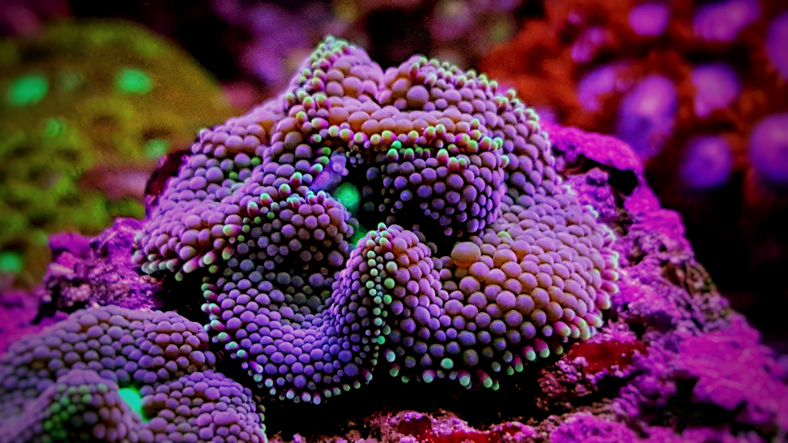
Whether you are looking to get ricordea, discosomas, or rhodactis – one thing is for sure, you will have no shortage of fun, colorful options! I always loved mushrooms because they often replicate quickly, so if (like me) you find yourself an avid mushroom farmer of the more rare mushrooms, you can get some great store credit at your local fish store for your extra mushrooms.
Zoanthids
Zoanthids, commonly known as zoas, are another easy-to-care-for coral. They come in a variety of colors and patterns and can add visual interest to any tank. They do require moderate flow levels and should be placed on a stable surface to anchor themselves.

One word of caution, and a reason why personally, I ditched zoas a long time ago: zoanthids contain a toxin that can be harmful to humans if ingested. Ask any local fish store if they have zoa fragging nightmare stories if you want to hear an interesting tale. Handle zoanthids with plenty of care, and avoid touching your face or mouth after handling them without washing your hands first. Also, just for extra safety, this is a coral that you may want to wear gloves around just to be safe.
Green Star Polyps
Green star polyps, often called “GSP” or “GSP coral,” are hardy and fast-growing coral. They can tolerate low to moderate lighting levels and do not require any specific placement requirements. They can also be easily fragged to create more colonies.
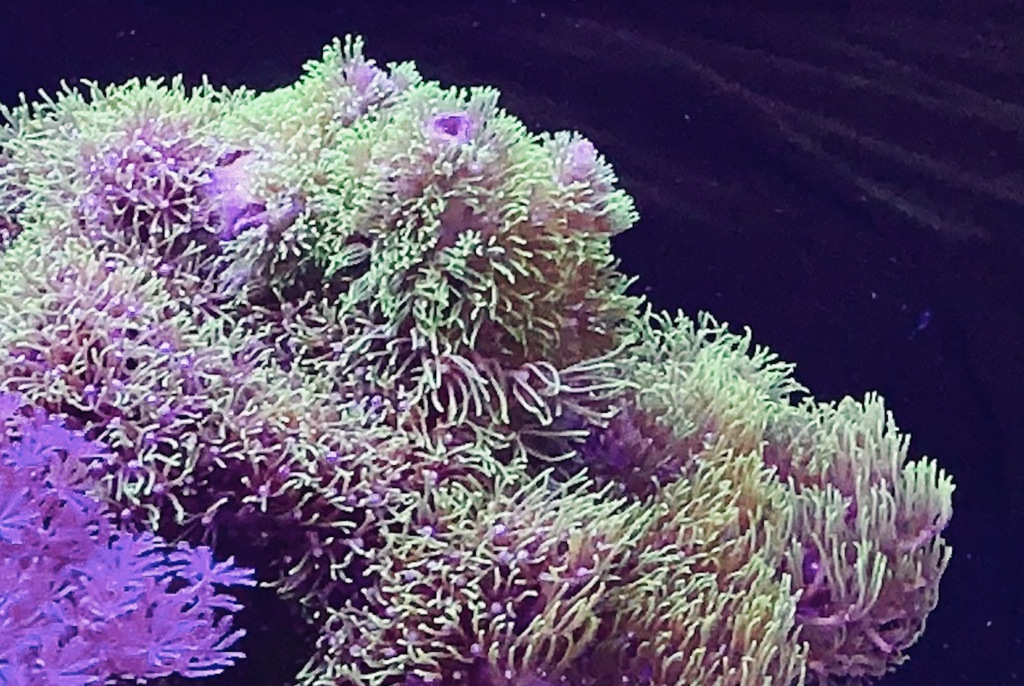
One thing to keep in mind with green star polyps is that they can grow quickly and become invasive if not properly managed. As someone who is a big fan of the carpeting nature of this coral, I plant it low and let it grow! If you plan to place this coral somewhere near another coral, be sure to watch and tend closely to ensure this coral doesn’t encroach on other corals’ territory. You can even frag and sell the excess if you do it right! You can also give it away to other beginners – which would make you super cool.
Toadstool Leather Corals
Toadstool leather corals are soft corals that can grow up to 12 inches in diameter. They are easy to care for and can adapt to a range of lighting and flow levels. They do require a stable surface to anchor themselves and plenty of space to grow.
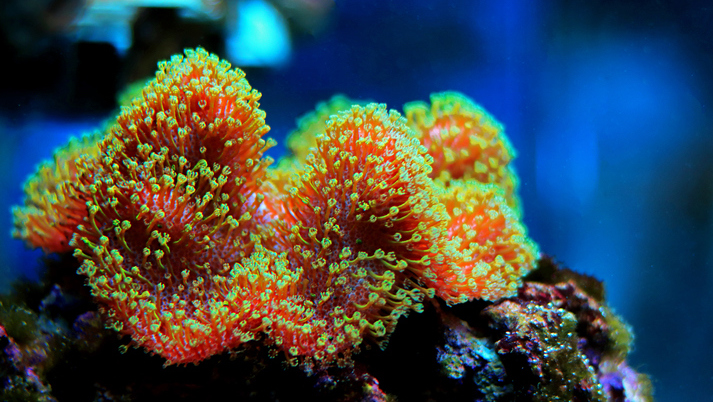
Toadstool leather corals can release toxins into the water if they become stressed or damaged. This can be harmful to other inhabitants of the tank, so it is important to monitor them closely and remove any damaged or dying coral promptly. Some people have stories of how toadstools “nuked” their tanks. This is a coral you will want to monitor because if it gets sick, it might try to take your whole tank down with it.
Xenia Corals
Xenia corals are soft corals with a unique pulsing movement. They are easy to care for and can tolerate low to moderate lighting and flow levels. They do require a stable surface to anchor themselves and should be placed away from other corals, as they can grow quickly and overtake their space.
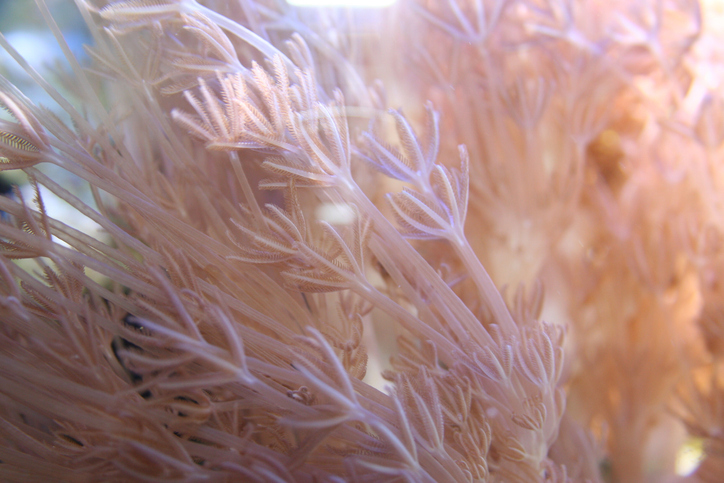
Xenia corals are named after the Greek word for “hospitality” due to their ability to quickly colonize new areas in the tank and provide a welcoming environment for other organisms. I am a big fan of the pulsing, waving motion of these corals, but I can attest that they have the ability to take over your whole tank. For that reason, you might want to exercise caution when planning to add this one to your reef.
Proper Coral Placement in Your Tank
Proper coral placement is important not only for the aesthetics of your tank but also for the health and growth of your corals. In this guide, we will discuss the various factors that should be taken into account when placing corals in your tank to ensure their well-being.
Lighting Requirements
One of the most important factors to consider when placing corals in your tank is their specific lighting requirements. Different types of corals have different needs when it comes to lighting. For example, soft corals, such as mushroom corals and leather corals, require the least amount of light, while SPS corals, such as acropora and montipora, require the most intense lighting.
When planning your reef, make sure you have the right amount of space, depth, and lighting strength to healthily maintain your new inhabitant. Upon placement of your corals, you can adjust your lighting system accordingly to replicate their natural environment as closely as possible. This will ensure that your corals receive the right amount and type of light they need to thrive.
Water Flow Considerations
Another important factor to consider when placing corals in your tank is water flow. Corals require a steady flow of water to bring them nutrients and remove waste products. However, it is important to ensure that the water flow is not too strong, as it can harm the delicate polyps of some corals.
When placing corals in your tank, it is important to consider the flow patterns in your aquarium. You can use powerheads and wavemakers to create a gentle current that will provide your corals with the flow they need without causing any damage.
Compatibility with Tank Mates
It is also important to consider the compatibility of your corals with other fish and invertebrates in your tank. Some species may harm your corals, either by nipping at their fleshy polyps or by damaging their hard skeleton.
For example, tangs and angelfish are known to nip at the fleshy polyps of some corals, while crabs and snails may damage the hard skeleton of SPS corals. It is important to research the compatibility of your corals with other species before adding them to your tank. This will help you to avoid any potential conflicts and ensure the long-term health of your corals.
By taking into account these factors when placing corals in your tank, you can ensure that they receive the right amount of light and water flow and are compatible with other species in your aquarium. This will help to promote their health and growth and ensure that your tank remains a beautiful and thriving ecosystem.
Feeding and Caring for Your Corals
Feeding and caring for your corals is crucial to ensuring their health and growth. Corals are delicate creatures that require specific care and attention to thrive. Let’s explore some best practices for feeding and caring for your corals.
Nutrient Requirements
Corals require specific nutrients to grow and maintain their vibrant colors. Calcium, alkalinity, and magnesium are all essential nutrients that corals need to thrive. It is important to test and maintain these levels regularly to ensure that your corals are getting the nutrients they need.
In addition to these essential nutrients, corals also require trace elements such as iron, iodine, and strontium. These trace elements are found in many commercially available salt mixes, but it is important to test and supplement them as needed.
Target Feeding vs. Broadcast Feeding
Feeding your corals can be done in two ways: target feeding and broadcast feeding.
Target feeding involves feeding the coral directly using a specialized tool or syringe. This method is best for LPS (large polyp stony) and SPS (small polyp stony) corals, as they require specific feeding to maintain their health and growth.
Broadcast feeding involves adding food to the entire tank for the corals to consume. This method is best for soft corals and filter feeders, as they can consume food particles that are suspended in the water column.
Monitoring Coral Health
Regularly monitoring your corals for signs of stress or disease is crucial for their health. Signs of stress include retracted polyps, discoloration, or tissue recession. If you notice any of these signs, it is important to take action immediately to prevent further damage.
Quarantining new coral additions and observing them for several weeks before adding them to your main display tank can prevent the spread of disease. It is also important to maintain good water quality, as poor water quality can lead to stress and disease in corals.
In conclusion, feeding and caring for your corals is essential to their health and growth. By maintaining proper nutrient levels, using the appropriate feeding methods, and monitoring coral health regularly, you can ensure that your corals thrive in your aquarium.
Common Challenges and Solutions for Salt Water Tank Beginners
Maintaining a saltwater tank can come with challenges. Algae control, maintaining water quality, and coral pests and diseases are some common challenges that beginners may face.
Algae Control
Algae control can be achieved by maintaining proper nutrient levels and flow levels in your tank. Reducing light exposure and manual removal can also control algae growth.
Maintaining Water Quality
Regular water changes and proper maintenance of equipment are important for maintaining water quality. Testing your water regularly and addressing any issues with urgency can prevent larger problems down the road.
Coral Pests and Diseases
Common coral pests and diseases include flatworms, red bugs, and coral bleaching. Quarantining new additions and observing for signs of stress or disease can prevent the spread of infection. Some pests you simply can’t avoid as they are part of a healthy ecosystem. Always watch your tank closely to ensure your corals remain healthy and your ecosystem remains balanced.
Expanding Your Coral Collection
Once you have mastered the basics of caring for your starter corals, you may want to try more challenging corals or expand your collection. Graduating to more advanced corals, coral fragging and propagation, and creating a thriving reef environment are some ways to expand your coral collection.
Graduating to More Advanced Corals
Once you feel comfortable caring for soft and LPS corals, you may want to try SPS corals. SPS corals are more challenging to care for and require higher lighting and flow levels, but they can add a unique element to your tank.
Coral Fragging and Propagation
Coral fragging and propagation involves safely breaking off a small piece of a coral and attaching it to a new surface to grow as a new coral. Think of it like how some succulents can regrow from single leaves. This is a great way to create more colonies and expand your collection. Given the variability of coral resilience, you definitely need to research the specific fragging requirements for your corals and use proper techniques to prevent injury or stress.
Creating a Thriving Reef Environment
Creating a thriving reef environment involves considering the entire ecosystem in your tank. Adding live rock, sand, and creating a healthy balance of fish and invertebrates can create a more natural and visually appealing environment for your corals.
Conclusion
Adding coral to your saltwater tank can be a beautiful and rewarding experience. Starting with durable and easy-to-care-for corals is important for beginners. Proper coral placement, feeding and caring for your corals, and common challenges and solutions should all be considered for the health and success of your tank. With patience, research, and dedication, you can create a thriving reef environment in your own home.

About the Author
With decades of experience, James shares his extensive knowledge in aquatics through this website, covering a broad series of topics related to the pond and aquarium hobby. Aiming to guide both beginners and experienced hobbyists alike, his goal is to help educate aquatic enthusiasts for the long-term betterment of the hobby as well as the environment. Learn More >>
Exploring Butterflyfish Species for Marine Aquarium Enthusiasts
Disclaimer: This blog shares my personal experiences, research, and insights as an aquatics hobbyist. While I strive to provide accurate information, please consult a professional or your local fish store for tailored advice on your specific tank setup. Remember,...
Exploring Basslets for Your Marine Aquarium
Disclaimer: This blog shares my personal experiences, research, and insights as an aquatics hobbyist. While I strive to provide accurate information, please consult a professional or your local fish store for tailored advice on your specific tank setup. Remember,...
The Six Line Wrasse: A Comprehensive Guide to Care and Keeping
Disclaimer: This blog shares my personal experiences, research, and insights as an aquatics hobbyist. While I strive to provide accurate information, please consult a professional or your local fish store for tailored advice on your specific tank setup. Remember,...
